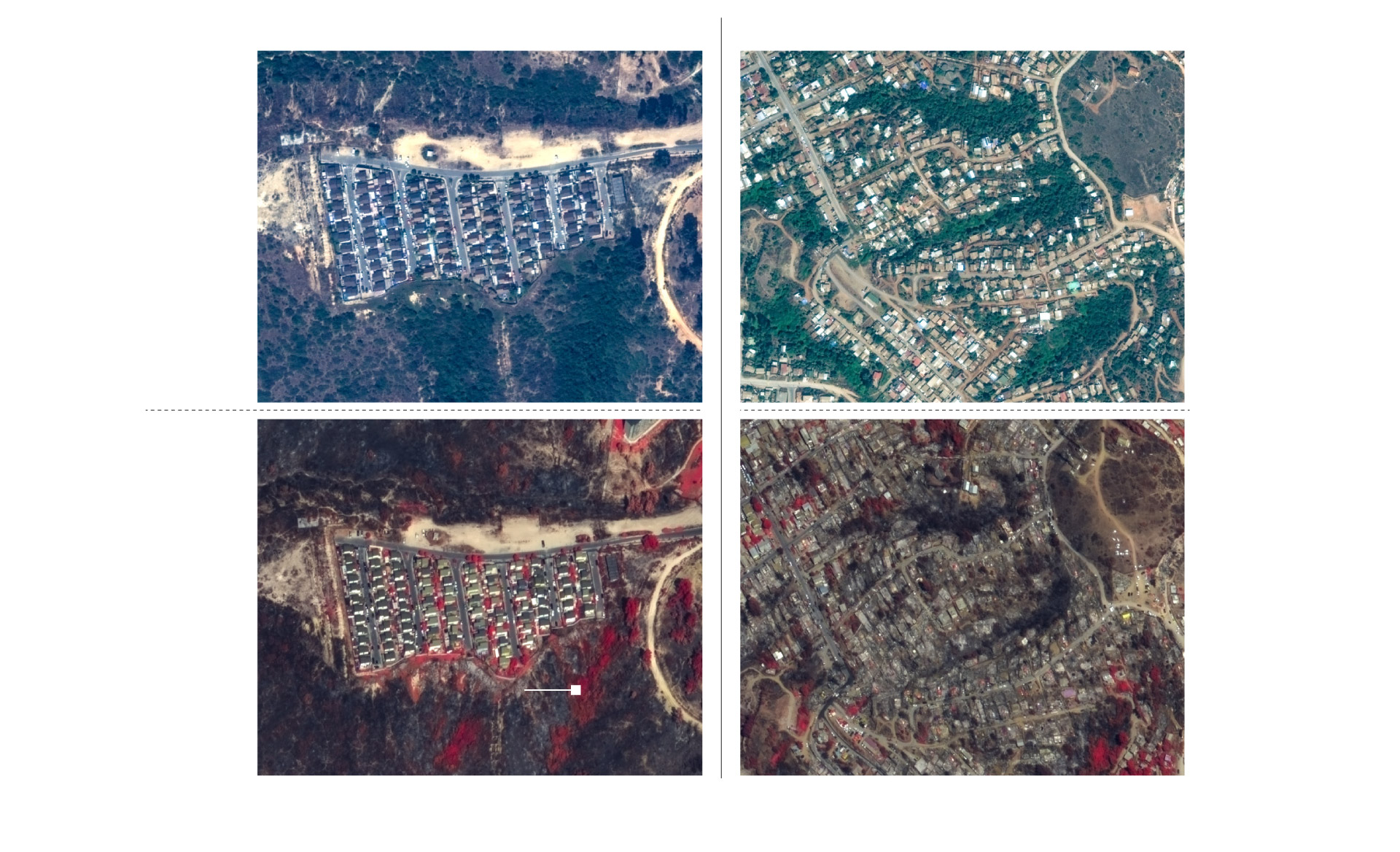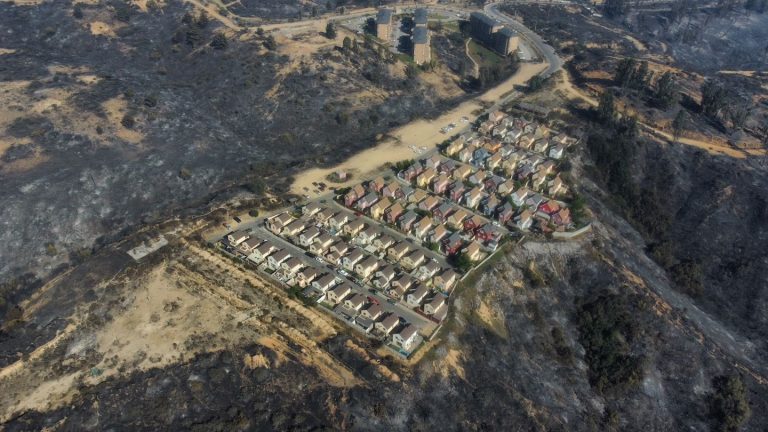But at the top of the hill, there was an amazing sight. In this desert of ash and soot, an oasis.
Botania shimmered on the hilltop, its elegant rows painted in bright colours Undamaged homes. Cars sat undisturbed on their ash-free roads.
This community of 80 or so homes somehow emerged unscathed from what is being called the deadliest fire in Chilean history. Viral social media posts and headlines of disbelief and awe in the past week.
“amazing!” The daily report said.
“what is the reason?” asked CHV Noticias.
The story of saving Botania while so much else was lost simultaneously points to possible solutions and preventative measures in a country and world dealing with increasingly devastating wildfires, while also revealing the stubborn social inequalities that often exacerbate such disasters.
Botania's escape was credited to the disciplined implementation of a fire prevention plan drawn up by Chilean forestry officials Local NGO, supported by the US government. Over the course of months, and with more than $20,000 in funding from USAID, community leaders purchased supplies and prepared for the next big fire.
“With tools and training, good things can happen,” said Tim Callahan, a senior official at USAID. “This is clearly a success.”
But as fires spread this month, eventually burning up to 6,000 homes and sending thousands into homelessness, the plan and training that had been so successful in Botania was not available in many of the communities that were found to need it most.

Burnt areas are black or gray
Not burned
Vegetation in red
Source: Maxar Technologies

Burnt areas are black or gray
Not burned
Vegetation in red
Source: Maxar Technologies

Burnt areas are black or gray
Not burned
Vegetation in red
Source: Maxar Technologies

Burnt areas are black or gray
Not burned
Vegetation in red
Source: Maxar Technologies
Where the fires were more devastating
Officials estimate that 70 percent of the destroyed homes in the area were concentrated in informal settlements called “illegal tomas.” Conditions in many settlements were so flammable—improper forest management, garbage-strewn streets, and homes built with cheap, flammable materials—that entire communities burned down within minutes.
It was a tragic reminder of Chile's failure to solve its ongoing housing crisis. In recent years, rising rents, coupled with stagnant incomes and the long shadow of the coronavirus pandemic, have put modular housing out of reach for tens of thousands of people. Many of them ended up at Thomas Eagles.
Spread Settlement operations coincided with a sharp escalation in forest fires. Authorities believe that the fires that broke out this month were started intentionally. But scientists say what has accelerated the fires' spread is a volatile combination of drought, climate change and El Niño. Three times the amount of land in Chile has burned in the past A decade ago compared to the previous decade, according to a study published in the journal Scientific Reports.
Fires in recent years have been particularly severe in central Chile, where the Valparaiso region, popular with tourists, It has been replenished by irregular sinuses. Nearly a quarter of all the country's illegal immigrants are found along its slopes and hills, populating more than 30,000 people, according to a national survey.
Some settlements are more established and have running water and electricity. Others are little more than a collection of wooden huts. The unpaved roads are full of debris. Flammable brush everywhere. Most of them are outside the scope of state services.
Sebastian Todd Navarro has lived all of his 25 years within one of these communities, Villa Independencia, which sits above a busy shopping mall. he He rarely feels supported For the state. For many years, isolated from city lines, his family had to obtain unofficial water and electricity.
He noticed the state's neglect again on the afternoon of February 2. The city caught fire Warning system. Until now Navarro said the first sign of danger wasn't his phone ringing, but the fire Spread below.
“A sight I can never forget,” he said.
She raced up the hill, taking advantage of all the brush and trash left throughout the community. The wooden huts exploded and caught fire.
Navarro said he drove the car Down the hill to safety. By the time he did, his community had virtually disappeared. It took no more than 10 minutes, according to news reports.
When Navarro returned, he found bodies everywhere. He said the bodies remained for several days. People covered them with metal cans to prevent dogs from feeding on them, while they waited for state employees to arrive to help transport them.
“We can no longer be spectators”
Negligence was not the story of Botania, whose path to redemption began in late 2022, with another fire. The fire spread to the nearby botanical garden, which contained some of the rarest tree species in the world, and burned nearly 10 acres.
Its proximity to Botania, a middle-class neighborhood built on an isolated hilltop and surrounded by flammable brush, terrified residents.
“We can no longer be spectators,” said Cecilia Chesternas, a resident of the city.
Meanwhile, Quilboy city officials asked if the neighborhood wanted to be part of a new pilot project. The city has identified Botania as one of the most vulnerable areas communities, and this project served as a way to begin preparing for the next fire. The inhabitants of Botania quickly agreed.
The initiative was led by a local NGO, Caritas Chile, which partnered with Chilean forest officials and received a grant from USAID in 2022 to train communities in fire prevention strategies. The new program was launched in 14 neighborhoods, covering more than 12,000 people. Informal settlements were deliberately excluded.
“Unfortunately, the reality of the settlements is complex,” said Quilboy Mayor Valeria Melipilan. “Almost all of them are in vulnerable areas, vulnerable to fires, floods and mass demolition – places where organized construction is not possible, which makes developing appropriate prevention plans there very complex.”
A USAID spokesperson said the organization wants to expand the program to include the most vulnerable communities. “Although slum areas were not included in the first phase of this programme, talks are ongoing on how to include additional at-risk communities in future phases,” the spokesperson said.
For Botania Forest officials in Chile have released a risk report to identify the greatest fire risks And train residents on how to treat it.
“The plan was simple,” said Simone Berti, president of the Chilean Society of Forest Engineers. “Eliminate all plants near houses. Cut down trees, clear all dry pastures.”
Residents of Botania immersed themselves in the secrets of forest fire prevention.
“I don’t work in the forests,” said Rodrigo Vargas, president of the Community Fire Prevention Organization. “I'm just another resident. We had to learn everything from scratch so we could master the basic concepts.
They cut a wide path around the community, removing all the debris to create a firebreak. They held weekly planning sessions and installed a command center equipped with a generator and walkie-talkies. They regularly cleared the surrounding area of all potentially flammable materials, cut down trees and collected garbage. They have learned to use water sprinklers to soak the ground to slow the progress of fires.
Then time ran out for preparations. The fire has arrived.
Comfort, happiness, then sadness
As people began to evacuate, Vargas became convinced that all their preparations had been for nothing. This hell was unlike anything he had ever seen.
“The power of fire,” he said. “Her violence.”
He reached a safe place below, where he waited for any information about what happened in Botania. Finally, a message from a neighbor: Botania is still standing. It wasn't burned.
Vargas couldn't believe it. The neighbor must have been wrong. Vargas waited until the fire died down. Then he climbed the hill on foot until he reached its peak.
“It was one of the nicest things,” he said. “He was still there.”
None of the homes were damaged.
But the relief and joy he felt was quickly replaced by sadness. He took a moment to take in the view from the neighborhood. There was only a black sea of ash.
His plants were all that survived.
McCoy reported from Rio de Janeiro. Marina Dias in Brasilia contributed to this report.
revision
An earlier version of this story said 10 people were arrested. Those arrests were in connection with a previous fire. The story has been updated.

